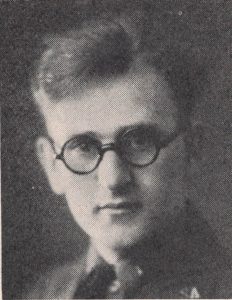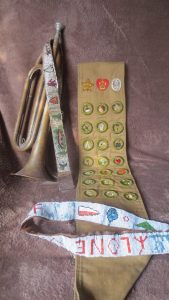For every immigrant group that arrives on America’s shores there is one major option to be weighed, how much should we assimilate and how much of our heritage should we maintain? For some, becoming Americanized quickly is paramount; others will staunchly remain rooted in the past, but most try to find some sort of balance. For Poles in Western New York who wanted their children to have the full American experience with a bit of Polish flavor they could sign them up to the local Boy Scouts of America troop, and if they were lucky they could spend a week at Camp Kosciuszko.
 The Boy Scouts of America were still in their infancy when the first troop was established in Buffalo’s Polonia. In 1911, when the Boy Scouts were only a year old, Joseph Sarnowski organized the Troop 9 at the Dom Polski on Broadway. A year later a second troop grew out of the Dom Polski, Troop 75. With these two troops, the scouts aggressively promoted themselves within the East Side with programs and demonstrations. At the same time Rt. Rev. Alexander Pitass started the first troop associated with a parish, Troop 1 at St. Stanislaus in Buffalo. The scouts were quickly becoming a popular extracurricular activity but over the next decade, only a few units would organize, including Troop 107 at St. John Kanty’s in 1925 bringing to total to about a half dozen.
The Boy Scouts of America were still in their infancy when the first troop was established in Buffalo’s Polonia. In 1911, when the Boy Scouts were only a year old, Joseph Sarnowski organized the Troop 9 at the Dom Polski on Broadway. A year later a second troop grew out of the Dom Polski, Troop 75. With these two troops, the scouts aggressively promoted themselves within the East Side with programs and demonstrations. At the same time Rt. Rev. Alexander Pitass started the first troop associated with a parish, Troop 1 at St. Stanislaus in Buffalo. The scouts were quickly becoming a popular extracurricular activity but over the next decade, only a few units would organize, including Troop 107 at St. John Kanty’s in 1925 bringing to total to about a half dozen.
To reinvigorate the Polish element in scouting, Leonard F. Gabryelewicz Scoutmaster of Troop 1 was promoted to field executive on the headquarters staff. Upon graduation from the National School for Scout Executives, Gabryelewicz became the first Polish American professional in the Boy Scouts of America.
While reigniting scouting amongst the Poles, Leonard, working with Father Stanislaus Sierakowski, a diocesan liaison for the scouts and secured a site near Sullivan Trail in Allegany Park for the Polish scouts. They named it Camp Kosciuszko. In 1926 the camp formally opened and in its first year, over 40 boys living in the city spent two weeks in nature. With the draw of Camp Kosciuszko, scouting experienced a second renaissance in Polonia and the number of troops almost doubled in a year. When Kosciuszko opened for its second summer, it filled up immediately, giving Father Stanislaus and Scoutmaster Gabryelewicz a workout as they managed the at capacity crowds. The camp proved to be so popular that the Buffalo Evening News began running a column in its scouting section called “Kosciuscko Kracks.”
 As much as Polonia was affected by scouting, scouting was affected by Polonia. By 1929, Anthony Adamski, Henry Rozan, Thaddeus Rudnicki, and Matthew Makowski, had all become Eagle Scouts and Edward Mellerski of Troop 1 even attended the Third World Scout Jamboree in Birkenhead, England. Camp Kosciuszko moved to Crystal Lake and became part of Scouthaven to accommodate all the Polish scouts wanting to stay at the camp, which at the time numbered over 600. Even as a sub-camp of Scouthaven, Kosciuszko imparted lifelong memories to its campers. In his twilight years eminent Polish American chronicler Edward Prabucki reminisced, “I recall one day we did some research in a wooded area and soon after it rained and lightning struck nearby trees.”
As much as Polonia was affected by scouting, scouting was affected by Polonia. By 1929, Anthony Adamski, Henry Rozan, Thaddeus Rudnicki, and Matthew Makowski, had all become Eagle Scouts and Edward Mellerski of Troop 1 even attended the Third World Scout Jamboree in Birkenhead, England. Camp Kosciuszko moved to Crystal Lake and became part of Scouthaven to accommodate all the Polish scouts wanting to stay at the camp, which at the time numbered over 600. Even as a sub-camp of Scouthaven, Kosciuszko imparted lifelong memories to its campers. In his twilight years eminent Polish American chronicler Edward Prabucki reminisced, “I recall one day we did some research in a wooded area and soon after it rained and lightning struck nearby trees.”
Eventually Camp Kosciuszko was folded into Scouthaven, but its grounds are still used by campers today. Following in the spirit of Scoutmaster Gabryelewicz, many Polish Americans have held leading positions in scouting in the Niagara Frontier and as of2017 one of the original six troops of Polonia continues to be active, Troop 107 at St. John Kanty’s Church.
Do you have any stories or memories about this location of the Polonia Trail? We would love to hear it! Please send us your story, and if it is chosen, it will be added to the site.
Send Your Story